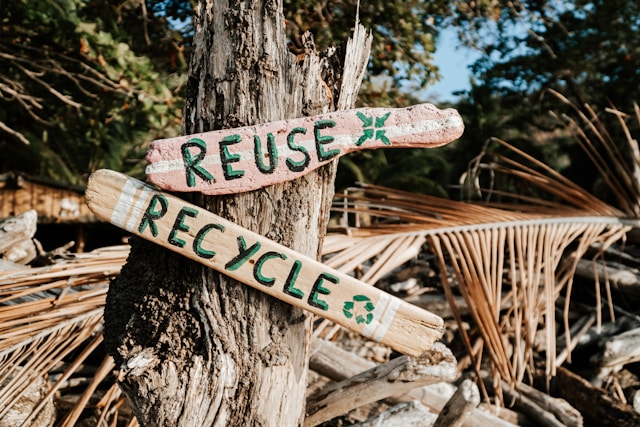The Secret Life of Materials: Understanding Circular Economy in Your Community

Trash trucks pass every block, but much of that so-called waste still has value. The take-make-dispose model sends usable materials to landfills instead of back into circulation. A circular economy flips that script for homes, schools and local businesses. It keeps products and materials circulating longer, reduces pollution and saves money over time.
This guide explains how the model works and shows clear steps for turning everyday items into useful resources close to home.
What Is the Circular Economy?
In a circular economy, materials never become waste. Products are circulated through maintenance, reuse, refurbishment, remanufacturing, recycling and composting. The model aims to grow local prosperity while using fewer finite resources.
Linear Economy vs. Circular Economy
A linear system extracts resources, builds products and then dumps them. A circular system designs products for a long life, keeps materials moving through second and third uses, and regenerates nature through better sourcing and soil-building practices. Those three shifts are critical to the definition of circular economy in practice and contrast the take-make-waste route.
Core Principles of Circular Economy
Think of these principles as your day-to-day playbook for circular living. Use them at home and work and in city programs to cut waste quickly and build long-term value.
- Design out waste: Choose durable, repairable parts and packaging you can recycle.
- Keep materials in use: Set up repair, resale, refill and return systems.
- Regenerate nature: Source renewably and restore soils with compost and cover crops.
Local Circular Economy Examples
Cities now scale curbside composting to cut landfill loads and feed soils. By late 2024, New York City expanded service to all five boroughs, creating the nation’s most extensive program and proving that a major metro can collect organics at the city scale. Your town can copy that playbook with drop-off hubs, school pilots and food-scrap carts.
Denver rolled out its Expanded Waste Collection Services in 2023, a pay-as-you-throw system that bills by trash cart size while including weekly recycling and compost at no extra charge. The pricing nudges households to downsize trash and divert more organics, which helps cut landfill emissions. Residents can choose cart sizes, request compost carts and manage pickup schedules through the city portal.
The Secret Life of Materials: Rethinking 4 Resources
These four everyday items carry real circular potential.
1. Food Waste
Divert scraps from trash. Landfilled food drives an outsized share of landfill methane because it breaks down fast. The Environmental Protection Agency (EPA) attributes about 58% of fugitive landfill methane to food waste. Composting and food rescue programs cut that impact.
2. Clothing
Before you buy new, choose repair, resale or local donation. Federal researchers report that textile waste has increased by over 50% since 2000, driven by fast fashion and thin collection systems. Community mending nights and buy-nothing groups keep fabric in use.
3. Electronics
Extend device life with repair, trade-in or certified e-waste drop-offs. You help recover metals, avoid toxic leakage and save money through upgrades instead of full replacements.
4. Batteries
Return car or equipment batteries to a recycler. Programs now recover all components of lead batteries. Manufacturers reuse the lead indefinitely with no performance loss, which makes lead batteries one of the most successfully recycled consumer products in the United States. Local auto shops often run core-exchange programs that handle this for you.
The Value Chain You Can Influence
You can shape circularity at each stage of a product’s life:
- Design: Favor goods with spare parts and published repair guides.
- Production: Support makers who use recycled feedstocks and renewable energy.
- Use: Maintain, share and repair to extend life.
- End-of-life: Return items to take-back, compost or certified recycling.
Builders face similar choices. Polyurethane insulation gained traction because it locks in gas bubbles and boosts thermal performance. Crews can also pick other efficient options. Icynene rivals aerogel in effectiveness, expands 100 times its size and can trim power bills by about 30%-50% when installed well.
The EPA’s latest work highlights why this matters. Landfills rank among the top human sources of methane, and food waste makes up roughly 24% of what we bury. Keeping organics out of landfills slashes methane quickly and returns nutrients to the soil.
Building a Circular Community: Actionable Steps
Whether you are a business owner, a local government representative or an individual passionate about sustainability, you can take steps to enhance the circular economy.
For individuals
Buy less and buy better. Choose durable goods you can repair. Try neighborhood swap groups or local buy-nothing pages before you purchase new ones. Save your food scraps for curbside composting or bring them to a nearby drop-off. Take batteries and leftover paint to a certified collection so recyclers can recover the materials safely.
For Businesses
Design products for longer life and easy disassembly. Offer repair, resale or returns to keep materials in motion. Source recycled inputs where quality allows, track material flows and set targets your team can hit. Many firms now see circularity as core to strategy, not a side project, with three-quarters of businesses recognizing its importance in 2024.
For Local Government
Adopt pay-as-you-throw, organics collection and safe-disposal events. Invest in compost sites, reuse depots and repair training. Support circular startups through grants or procurement that require recycled content and repairability. The EPA’s annual data program helps leaders benchmark progress and decide where to invest next.
Participate in Your Neighborhood
Circular economy work does not require perfection. It needs clear design choices, easy return paths and local systems that make the better option the default. Start with organics, clothing, electronics and batteries. Support brands and city programs that keep materials moving. As more communities add curbside composting, repair access and smart returns, the secret life of materials becomes visible — and valuable — for everyone.

